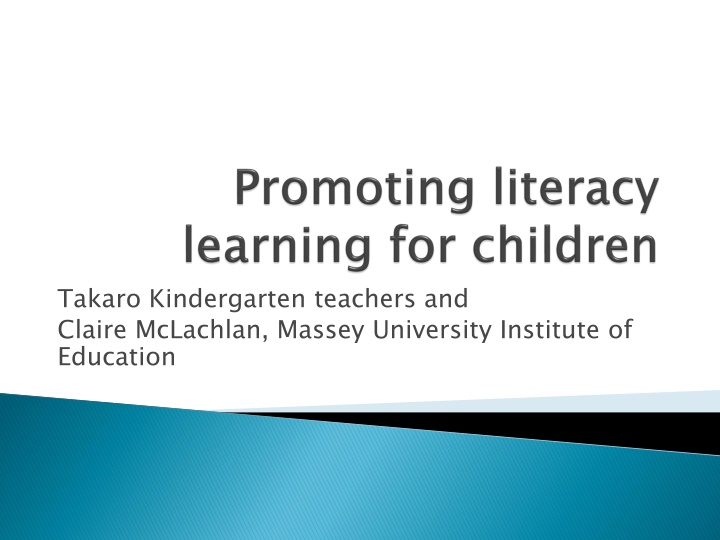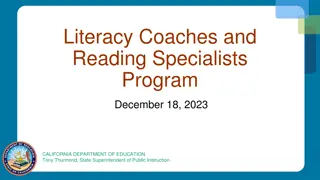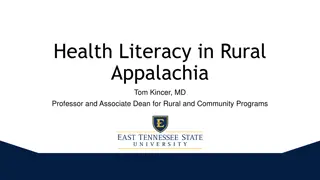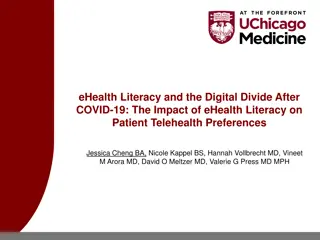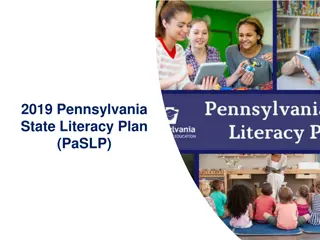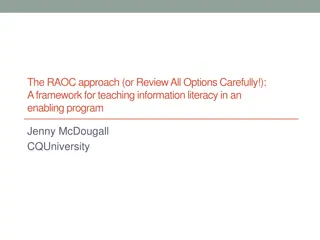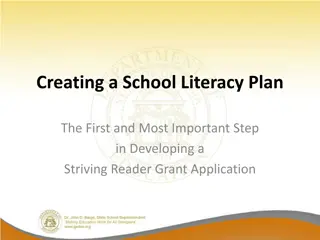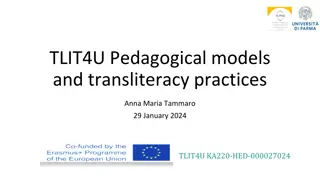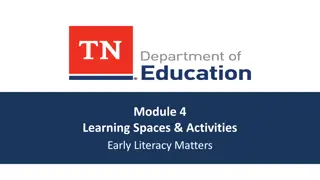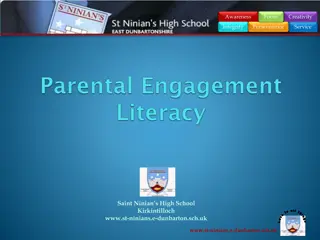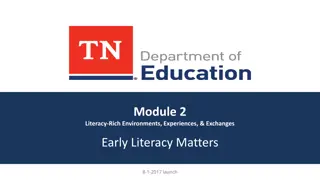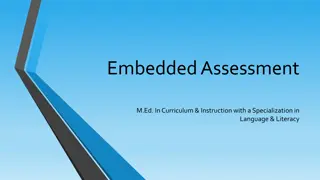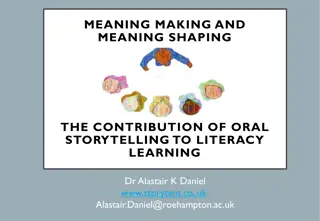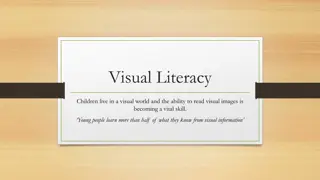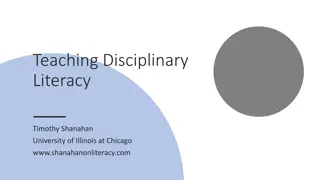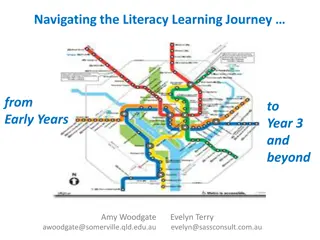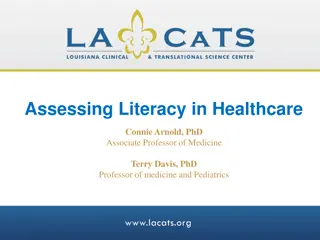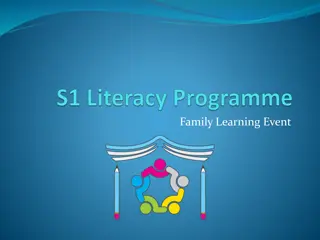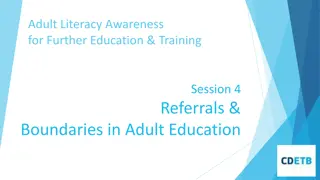Enhancing Literacy Learning in Kindergartens
Takaro Kindergarten, in collaboration with Dr. Claire McLachlan from Massey University, is delving into how collaborative planned reviews with teachers can boost literacy outcomes for children aged three to five. This research aims to explore the impact of such reviews on teachers' literacy knowledge, pedagogical practices, and children's literacy skills. The approach emphasizes a safe and fun learning environment, with a focus on interaction and routines. The study examines the potential changes in literacy-related practices and outcomes through collaborative initiatives in low socioeconomic kindergartens.
Download Presentation

Please find below an Image/Link to download the presentation.
The content on the website is provided AS IS for your information and personal use only. It may not be sold, licensed, or shared on other websites without obtaining consent from the author.If you encounter any issues during the download, it is possible that the publisher has removed the file from their server.
You are allowed to download the files provided on this website for personal or commercial use, subject to the condition that they are used lawfully. All files are the property of their respective owners.
The content on the website is provided AS IS for your information and personal use only. It may not be sold, licensed, or shared on other websites without obtaining consent from the author.
E N D
Presentation Transcript
Takaro Kindergarten teachers and Claire McLachlan, Massey University Institute of Education
Takaro philosophy - Ako Takaro Philosophy - Whanau involvement Philosophy Explanation Philosophy Explanation At Takaro Kindergarten we will provide a safe, fun learning environment for children and whanau to grow in their confidence and competence. Takaro Kindergarten Logo was created by a committee and whanau in early 2000. It embraces the wairua of this learning community. The large tree in the middle depicts the adult s position in the nurturing of children, which are the two young trees on each side. The roots of the tree are the six strands of the philosophy that permeates the life and being of Takaro Kindergarten.
We attended a meeting regarding a Massey Research proposal for research into literacy in ECE. PSM (professional Service Managers) focus As a team we decided regardless of whether the research went ahead we wanted to focus on literacy as our planned review.
We were ably supported by Karen McKay from Massey CED. Karen became our reflective critical friend.
Looked kindergarten environment and how they were being used Concentrated on interactions with children Looked at our routines with children and adjusted Emergent review at various areas within the
Our planned review was underway when we found out the research was to go ahead with Dr Claire McLachlan (now professor). This complemented what we were doing. sat alongside our review and
Aim: To examine if collaborative planned reviews with teachers in low SES kindergartens will enhance literacy learning outcomes in children aged three to five years of age. Research questions: Can collaborative planned reviews with kindergarten teachers in low SES settings increase knowledge of literacy? Can collaborative planned reviews with kindergarten teachers change pedagogical practices related to literacy? Do changes in knowledge and pedagogies in teachers relate to changes in children s literacy knowledge, skills and abilities?
A mixed methodology was used. Mixed methods research designs are used when researchers need to examine many elements of a research problem and require both quantitative and qualitative data to answer research questions (Punch, 2009). Our design included the following: Pre and post interviews with teachers Pre, mid and post measures of children s literacy Parent survey Meetings with teachers to discuss findings and explore options for developing the review
Phonological awareness awareness of sound Rhyme Onset Onset labelling Phonological awareness segmentation Emergent literacy skills Letter name Letter sound Own name reading Own name writing Receptive vocabulary Reading
The ways in which we supported literacy were simple yet effective. Increased use of alphabet by making alphabet resources using stones and sandpaper Using alphabet resources inside and outside Purchased an Ipad Put writing materials inside and outside Increased kindergarten Increased use of playdough and gloop for letter recognition literacy resources in the
letter recognition having fun with letters Tactile alphabet resources Musical letters Exploring writing Portable resources Role play Imaginative play with puppets Music, drama, dance Rhyme awareness Phonological awareness with puppets (turtle talk) Resources at accessible points Movement and learning
New entrant teacher from Takaro School: I can tell the children that come from Takaro Kindergarten, they are ready, willing and able to give it a go
In the beginning the majority of documentation was related to using literacy for a purpose. As teachers we where quite confident that a child was learning literacy for a purpose but the line is more blurred with critically questioning and transforming. We are now using repertoires of practice to support children to critically question and transform and self assess their knowledge, children's identities evolved and strengthened as a result.
We had more literacy opportunities inside than outside. Now we have developed portable resources that can be used outside as well as making tactical resources that children could interact with.
Reinforced our view of childrens multimodal way of learning. We now have a greater understanding of multiple literacy practice required to ensure all children add to what they know and are already good at. Parents literacy survey revealed that a number of families 15/20 tell oral stories which was quite high. We weaved this more intentionally into our programme. Children s language, culture and identity strengthened as a result.
For teachers we found we are more focused on where the learning had come from and knowing the families. For children this has meant their previous learning is more valued. More emphasis has been placed on Families contributions and this has resulted in increased confidence and self esteem of whanau .
The initial data revealed that there were three main areas of literacy to focus on: phonological awareness; receptive vocabulary; and letter recognition. Highlighted that half of the children have access to I-pad and I-phone at home. We were not aware of this so it throws up possible avenue of communication and the need for partnership with parents, give them tips they can use at home. Claire's parent survey revealed they were not aware of the literacy learning that occurred through play at kindergarten. In response we held a literacy hui and had fantastic feedback.
27 children at the beginning of review 19 children at the middle of the review 16 children by the end of the review Reason for the drop in numbers is that children went to school! We are only reporting the children who did pre, mid and post measures here.
Literacy measures Alpha names Alpha sounds Name reading Name writing Rhyme (max 8) Onset (max 8) Onset name (max 8) PA segment Vocab Literacy measures Pre ave. 8 8.6 8 yes 4 yes 3.3 3.0 5.0 Pre ave. Range Range Mid ave. 7.8 16.7 10 yes 4 yes 3.8 3.4 4.0 Mid ave. Range Range Post Ave. 9.2 11.4 12 yes 7 yes 4.1 3.0 3.25 Post Ave. Range Range 0-24 2-13 0-26 1-21 0-26 1-21 0-8 1-6 3-7 1-8 1-8 0-8 2-8 1-8 0-7 0 93.4 1 97.3 1 99.4 55-112 76- 117 76- 117
Increased use of alphabet by making alphabet resources using stones and sandpaper Using alphabet resources inside and outside Purchased an Ipad Put writing materials inside and outside Increased literacy resources in the kindergarten Increased use of playdough and gloop for letter recognition
Increased focus on high frequency words Increased focus on reading stories, singing nursery rhymes and waiata and songs from other languages Increased use of mats and cushions outside for reading Increased focus on selecting stories and resources to support learning of alphabet, sounds, new words
All teachers said they were more confident about how to promote literacy in different ways All said they had thought deeply about how to support and extend children s literacy and how to use literacy resources more purposefully in the kindergarten All considered they were supporting foundational skills like fine motor skills for writing and supporting knowledge of alphabet and awareness of sounds All discussed using resources to promote specific skills, such as puppets for phonological awareness and letter name resources for alphabet and writing All commented that they were looking more explicitly at the link between teaching and children s outcomes and discussed issues related to assessment
Preliminary indications are that children have increased knowledge and skills at Takaro and grown in confidence with their literacy abilities. Teachers consider that their understanding and confidence of how to support literacy has increased and that their literacy teaching practices have become more purposeful. Although this planned review is a resource intensive model involving researchers and CED staff, it has promoted changes in teachers beliefs and practices and children s literacy outcomes. The literacy measures have been useful in this study and there are implications for developing literacy resources that can be used by teachers for simple assessment of literacy progress.
